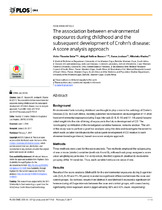| dc.contributor.author | Sabe, Victor Tinashe | |
| dc.contributor.author | Basson, Abigail | |
| dc.contributor.author | Jordaan, Esme | |
| dc.contributor.author | Mazinu, Mikateko | |
| dc.date.accessioned | 2017-03-13T07:22:09Z | |
| dc.date.available | 2017-03-13T07:22:09Z | |
| dc.date.issued | 2017 | |
| dc.identifier.citation | Sabe, V.T. et al. (2017). The association between environmental exposures during childhood and the subsequent development of Crohn's Disease: A score analysis approach. PLoS ONE, 12(2): Art. #e0171742 | en_US |
| dc.identifier.issn | 1932-6203 | |
| dc.identifier.uri | http://hdl.handle.net/10566/2618 | |
| dc.identifier.uri | http://dx.doi.org/10.1371/journal.pone.0171742 | |
| dc.description.abstract | Background Environmental factors during childhood are thought to play a role in the aetiology of Crohn's Disease (CD). In South Africa, recently published work based on an investigation of 14 childhood environmental exposures during 3 age intervals (0-5, 6-10 and 11-18 years) has provided insight into the role of timing of exposure in the future development of CD. The 'overlapping' contribution of the investigated variables however, remains unclear. The aim of this study was to perform a post hoc analysis using this data and investigate the extent to which each variable contributes to the subsequent development of CD relative to each aforementioned age interval, based on a score analysis approach. Methods Three methods were used for the score analysis. Two methods employed the subgrouping of one or more (similar) variables (methods A and B), with each subgroup assigned a score value weighting equal to one. For comparison, the third approach (method 0) involved no grouping of the 14 variables. Thus, each variable held a score value of one. Results Results of the score analysis (Method 0) for the environmental exposures during 3 age intervals (0-5, 6-10 and 11-18 years) revealed no significant difference between the case and control groups. By contrast, results from Method A and Method B revealed a significant difference during all 3 age intervals between the case and control groups, with cases having significantly lower exposure scores (approximately 30% and 40% lower, respectively). Conclusion Results from the score analysis provide insight into the 'compound' effects from multiple environmental exposures in the aetiology of CD. | en_US |
| dc.language.iso | en | en_US |
| dc.publisher | Public Library of Science | en_US |
| dc.rights | © 2017 Sabe et al. This is an open
access article distributed under the terms of the
Creative Commons Attribution License, which
permits unrestricted use, distribution, and
reproduction in any medium, provided the original
author and source are credited. | |
| dc.subject | Environmental exposure | en_US |
| dc.subject | Childhood | en_US |
| dc.subject | Chron's disease | en_US |
| dc.subject | Score analysis | en_US |
| dc.title | The association between environmental exposures during childhood and the subsequent development of Crohn's Disease: A score analysis approach | en_US |
| dc.type | Article | en_US |
| dc.privacy.showsubmitter | FALSE | |
| dc.status.ispeerreviewed | TRUE | |
| dc.description.accreditation | ISI | en_US |

